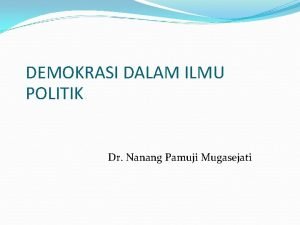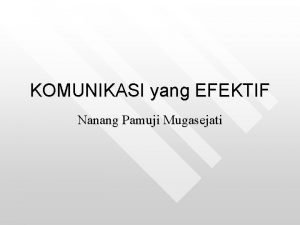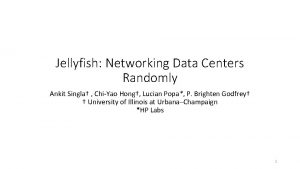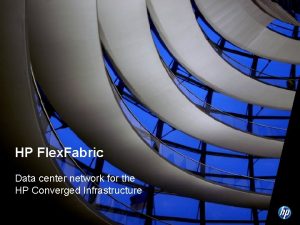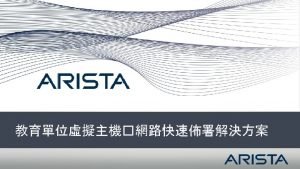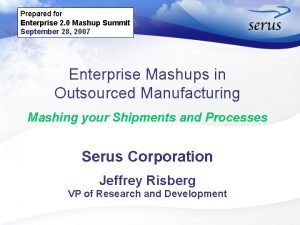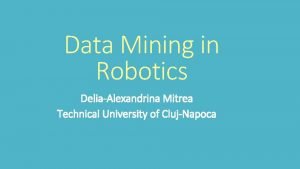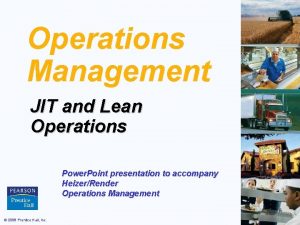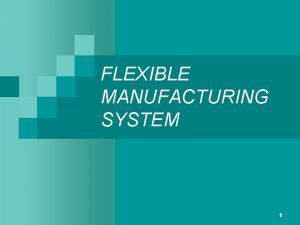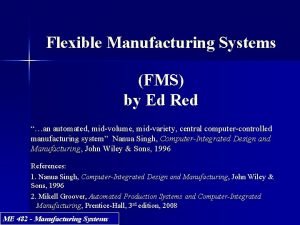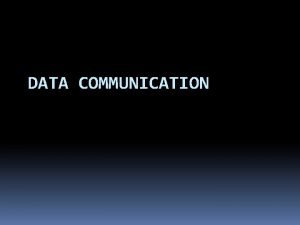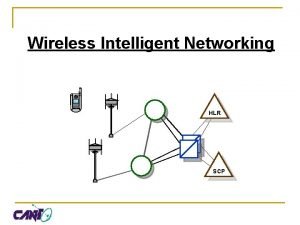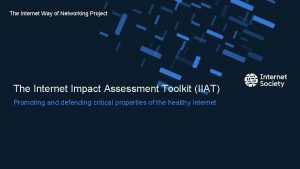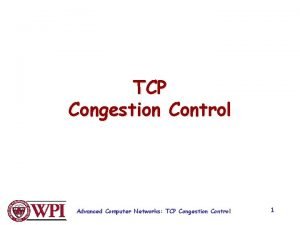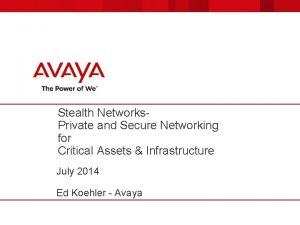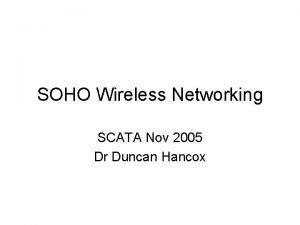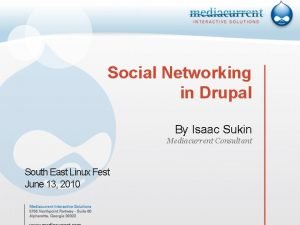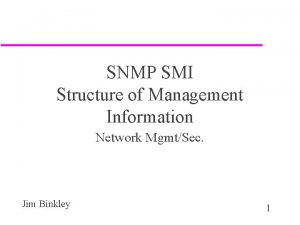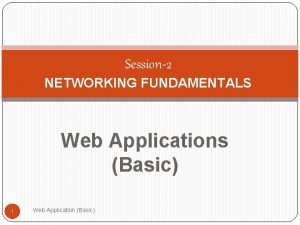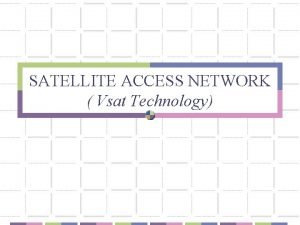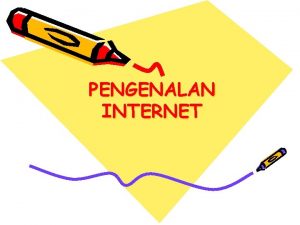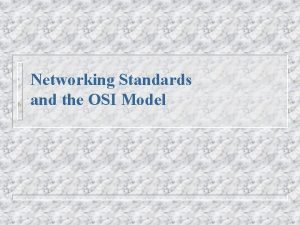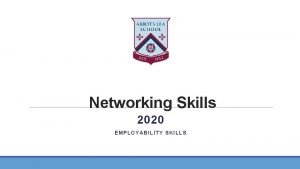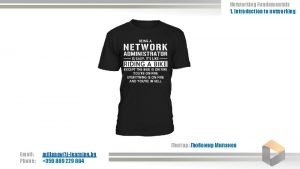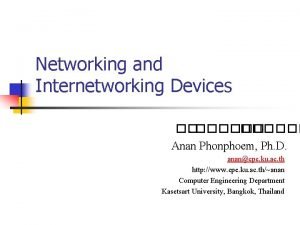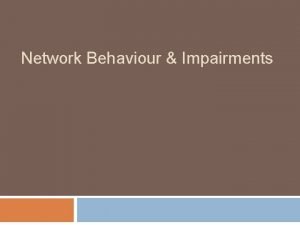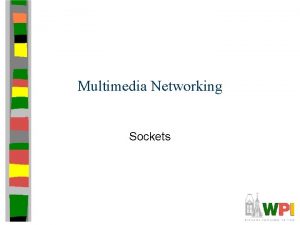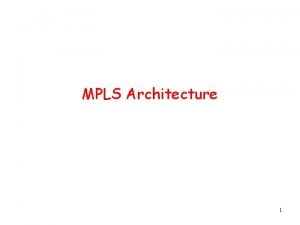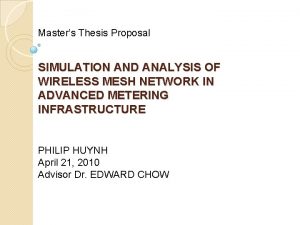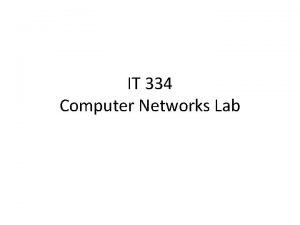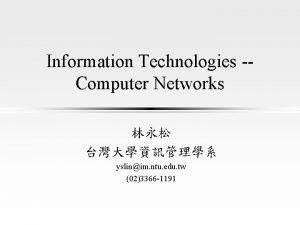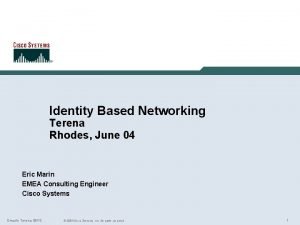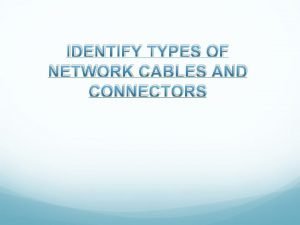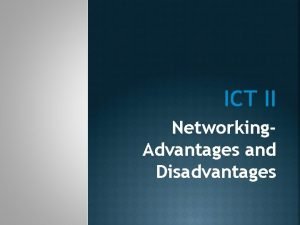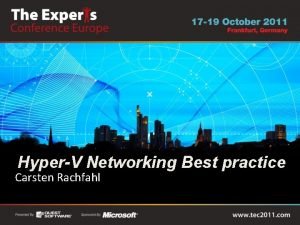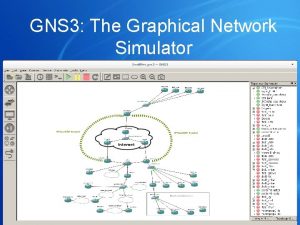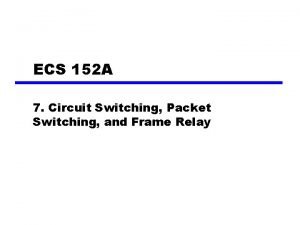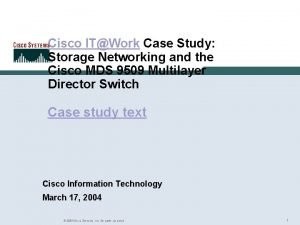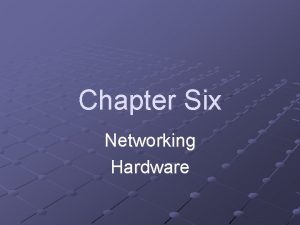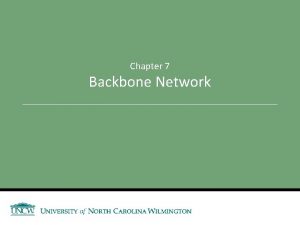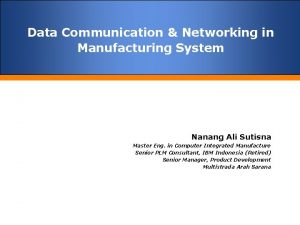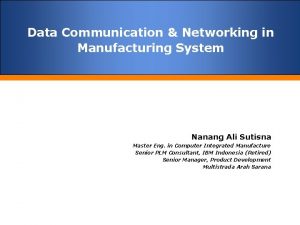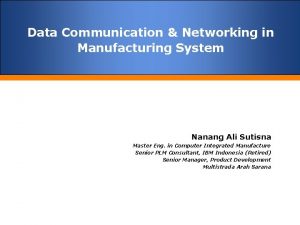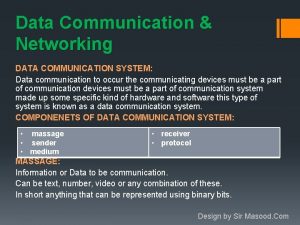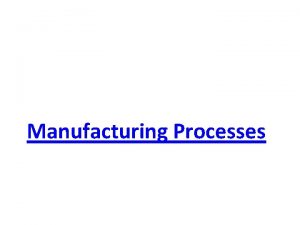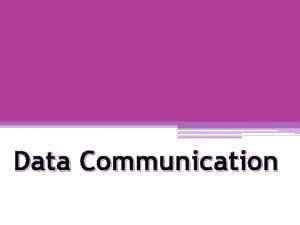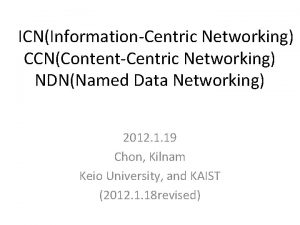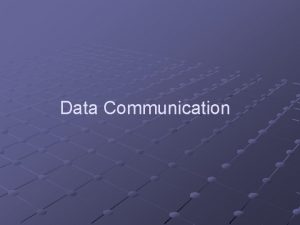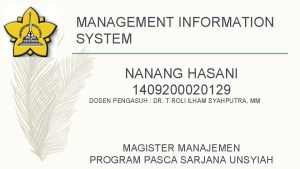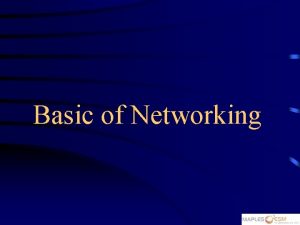Data Communication Networking in Manufacturing System Nanang Ali
































































- Slides: 64

Data Communication & Networking in Manufacturing System Nanang Ali Sutisna Master Eng. in Computer Integrated Manufacture Senior PLM Consultant, IBM Indonesia (Retired) Senior Manager, Product Development Multistrada Arah Sarana

Data Communication & Networking in Manufacturing System Chapter 4 Data Communication Fundamental

What is data communication? t Not to be confused with telecommunication • Any process that permits the passage from a sender to one or more receivers of information of any nature, delivered in any easy to use form by any electromagnetic system. t Data communication • Defined as a subset of telecommunication involving the transmission of data to and from computers and components of computer systems. • More specifically data communication is transmitted via mediums such as wires, coaxial cables, fiber optics, or radiated electromagnetic waves such as broadcast radio, infrared light, microwaves, and satellites.

History of Telecommunications t Invention of telegraph Samuel Morse – 1837 t Invention of telephone- Alexander Graham Bell – 1876 t Development of wireless By ? ? ? – 1896 t Concept of universal access and growth of AT&T t Divestiture of AT&T—what year? ?

History of Telecommunications Continued…. t Telecommunications Act of 1996 t Three main developments that led to the growth of data communications systems: • Large-scale integration of circuits reduced the cost and size of terminals and comm equipment • Developments of software systems made establishment of communication networks easy • Competition among providers of transmission facilities reduced the cost of data circuits

History of Data Communication t Transistor developed by Bell Labs 1947 t Hush-a-Phone Case t Carterphone case t MCI and Long Distance t Creation of networks (LAN’s and WAN’s) t Data Link Protocols t Microcomputers

History of the Internet 1836 -- Telegraph. Cooke and Wheatstone patent it. Why is this relevant? • Revolutionized human telecommunications. • Morse Code a series of dots and dashes used to communicate between humans. This is not a million miles away from how computers communicate via (binary 0/1) data today. Although it is much slower!! 1858 -1866 -- Transatlantic cable. Allowed direct instantaneous communication across the Atlantic. Why is this relevant? • Today, cables connect all continents and are still a main hub of telecommunications. 1876 -- Telephone. Alexander Graham Bell Exhibits. Why is this relevant? • Telephones exchanges provide the backbone of Internet connections today. • Modems provide Digital to Audio conversions to allow computers to connect over the telephone network.

1957 -- USSR launches Sputnik, first artificial earth satellite. Why is this relevant? • The start of global telecommunications. Satellites play an important role in transmitting all sorts of data today. • In response, US forms the Advanced Research Projects Agency (ARPA) within the Department of Defense (Do. D) to establish US lead in science and technology applicable to the military. 1962 - 1968 -- Packet-switching (PS) networks developed Why is this relevant? • As we will see later the Internet relies on packets to transfer data. • The origin is military : for utmost security in transferring information of networks (no single outage point). • Data is split into tiny packets that may take different routes to a destination. • Hard to eavesdrop on messages. • More than one route available -- if one route goes down another may be followed. Networks can withstand large scale destruction (Nuclear attack - This was the time of the Cold War).

1969 -- Birth of Internet ARPANET commissioned by Do. D for research into networking. Why is this relevant? • First node at UCLA (Los Angeles) closely followed by nodes at Stanford Research Institute, UCSB (Santa Barbara) and U of Utah (4 Nodes). 1971 -- People communicate over a network • 15 nodes (23 hosts) on ARPANET. • E-mail invented -- a program to send messages across a distributed network. Why is this relevant? E-mail is still the main way of inter-person communication on the Internet today. You will make extensive use of E-mail for the rest of your life. 1972 -- Computers can connect more freely and easily • First public demonstration of ARPANET between 40 machines. • Internetworking Working Group (INWG) created to address need for establishing agreed upon protocols. Why is this relevant? Telnet specification Telnet is still a relevant means of inter-machine connection today.

1973 -- Global Networking becomes a reality • First international connections to the ARPANET: University College of London (England) and Royal Radar Establishment (Norway) • Ethernet outlined -- this how local networks are basically connected today. • Internet ideas started. • Gateway architecture sketched on back of envelope in hotel lobby in San Francisco. Gateways define how large networks (maybe of different architecture) can be connected together. • File Transfer protocol specified -- how computers send and receive data. 1974 -- Packets become mode of transfer • Transmission Control Program (TCP) specified. Packet network Intercommunication -the basis of Internet Communication. • Telnet, a commercial version of ARPANET, opened -- the first public packet data service.

1976 -- Networking comes to many • Queen Elizabeth sends out an e-mail. • UUCP (Unix-to-Unix Co. Py) developed at AT&T Bell Labs and distributed with UNIX. Why is this relevant? UNIX was and still is the main operating system used by universities and research establishments. These machines could now ``talk'' over a network. Networking exposed to many users worldwide. 1977 -- E-mail takes off, Internet becomes a reality • Number of hosts breaks 100. • THEORYNET provides electronic mail to over 100 researchers in computer science (using a locally developed E-mail system and TELNET for access to server). • Mail specification • First demonstration of ARPANET/Packet Radio Net/SATNET operation of Internet protocols over gateways.

1979 -- News Groups born • Computer Science Department research computer network established in USA. • USENET established using UUCP. Why is this relevant? USENET still thrives today. A collection of discussions groups, news groups. 3 news groups established by the end of the year Almost any topic now has a discussion group. • First MUD (Multiuser Dungeon) -- interactive multiuser sites. Interactive adventure games, board games, rich and detailed databases. • ARPA establishes the Internet Configuration Control Board (ICCB). • Packet Radio Network (PRNET) experiment starts with ARPA funding. Most communications take place between mobile vans.

1981 -- Things start to come together • BITNET, the "Because It's Time NETwork" Started as a cooperative network at the City University of New York, with the first connection to Yale Provides electronic mail and listservers to distribute information, as well as file transfers • CSNET (Computer Science NETwork) established to provide networking services (specially E-mail) to university scientists with no access to ARPANET. CSNET later becomes known as the Computer and Science Network. 1982 -- TCP/IP defines future communication • DCA and ARPA establishes the Transmission Control Protocol (TCP) and Internet Protocol (IP), as the protocol suite, commonly known as TCP/IP, for ARPANET. Why is this relevant? Leads to one of the first definitions of an internet as a connected set of networks, specifically those using TCP/IP, and Internet as connected TCP/IP internets. • EUnet (European UNIX Network) is created by EUUG to provide E-mail and USENET services. Original connections between the Netherlands, Denmark, Sweden, and UK External Gateway Protocol specification -- EGP is used for gateways between (different architecture) networks.

1983 -- Internet gets bigger • Name server developed. Why is this relevant? Large number of nodes. Hard to remember exact paths Use meaningful names instead. • Desktop workstations come into being. Why is this relevant? Many with Berkeley UNIX which includes IP networking software. Need switches from having a single, large time sharing computer connected to Internet per site, to connection of an entire local network. • Internet Activities Board (IAB) established, replacing ICCB • Berkeley releases new version of UNIX 4. 2 BSD incorporating TCP/IP. • EARN (European Academic and Research Network) established on similar lines to BITNET

1984 -- Growth of Internet Continues • Number of hosts breaks 1, 000. • Domain Name Server (DNS) introduced. instead of 123. 456. 789. 10 it is easier to remember something like www. myuniversity. mydept. mynetwork. mycountry ( e. g. www. cs. cf. ac. uk). • JANET (Joint Academic Network) established in the UK • Moderated newsgroups introduced on USENET. 1986 -- Power of Internet Realised • 5, 000 Hosts. 241 News groups. • NSFNET created (backbone speed of 56 Kbps) • NSF establishes 5 super-computing centers to provide high-computing power for all -This allows an explosion of connections, especially from universities. • Network News Transfer Protocol (NNTP) designed to enhance Usenet news performance over TCP/IP.

1987 -- Commercialization of Internet Born • Number of hosts 28, 000. • UUNET is founded with Usenix funds to provide commercial UUCP and Usenet access. 1988 • 2 November - Internet worm burrows through the Net, affecting ~6, 000 of the 60, 000 hosts on the Internet • CERT (Computer Emergency Response Team) formed by DARPA in response to the needs exhibited during the Morris worm incident. The worm is the only advisory issued this year. • NSFNET backbone upgraded to T 1 (1. 544 Mbps) • Internet Relay Chat (IRC) developed 1989 -- Large growth in Internet • Number of hosts breaks 100, 000 • First relays between a commercial electronic mail carrier and the Internet • Internet Engineering Task Force (IETF) and Internet Research Task Force (IRTF) comes into existence under the IAB

1990 -- Expansion of Internet continues • Electronic Frontier Foundation (EFF) is founded by Mitch Kapor • 300, 000 Hosts. 1, 000 News groups • ARPANET ceases to exist • Archie released files can be searched and retrieved (FTP) by name. • The World comes on-line (world. std. com), becoming the first commercial provider of Internet dialup access. 1991 -- Modernization Begins • Commercial Internet e. Xchange (CIX) Association, Inc. formed after NSF lifts restrictions on the commercial use of the Net. • PGP (Pretty Good Privacy) released by Philip Zimmerman • US High Performance Computing Act (Gore 1) establishes the National Research and Education Network (NREN) • Wide Area Information Servers (WAIS) Why is relevant? Provides a mechanism for indexing and accessing information on the Internet. Large bodies of knowledge available: E-mail messages, text, electronic books, Usenet articles, computer code, image, graphics, sound files, databases etc. . These form the basis of the index of information we see on WWW today. Powerful search techniques implemented. Keyword search.

1991 (cont) -- Friendly User Interface to WWW established • Gopher released by Paul Lindner and Mark P. Mc. Cahill from the U of Minnesota. Why is relevant? Text based, menu-driven interface to access internet resources. No need to remember or even know complex computer command. User Friendly Interface (? ). Largely superseded by WWW, these days. -- Most Important development to date • World-Wide Web (WWW) released by CERN; Tim Berners-Lee developer. Why is relevant? Originally developed to provide a distributed hypermedia system. Easy access to any form of information anywhere in the world. Initially non-graphic (this came later, MOSAIC, 1993). Revolutionized modern communications and even our, way of life (? ). • NSFNET backbone upgraded to T 3 (44. 736 Mbps). NSFNET traffic passes 1 trillion bytes/month and 10 billion packets/month • Start of JANET IP Service (JIPS) using TCP/IP within the UK academic network.

1992 - Multimedia changes the face of the Internet • Number of hosts breaks 1 Million. News groups 4, 000 • Internet Society (ISOC) is chartered. • First MBONE audio multicast (March) and video multicast (November). • The term "Surfing the Internet" is coined by Jean Armour Polly. 1993 -- The WWW Revolution truly begins • Number of Hosts 2 Million. 600 WWW sites. • Inter. NIC created by NSF to provide specific Internet services directory and database services registration services information services • Business and Media really take notice of the Internet. • US White House and United Nations (UN) comes on-line. • Mosaic takes the Internet by storm. Why is this relevant? User Friendly Graphical Front End to the World Wide Web. Develops into Netscape -- most popular WWW browser to date.

1994 -- Commercialization begins • Number of Hosts 3 Million. 10, 000 WWW sites. 10, 000 News groups. • ARPANET/Internet celebrates 25 th anniversary • Local communities begin to be wired up directly to the Internet (Lexington and Cambridge, Mass. , USA) • US Senate and House provide information servers • Shopping malls, banks arrive on the Internet A new way of life You can now order pizza from the Hut online in the US. First Virtual, the first cyberbank, open up for business • NSFNET traffic passes 10 trillion bytes/month • WWW edges out telnet to become 2 nd most popular service on the Net (behind ftp-data) based on % of packets and bytes traffic distribution on NSFNET • UK's HM Treasury on-line (http: //www. hm-treasury. gov. uk/) • First cyberstation, RT-FM, broadcasts from Interop in Las Vegas • Arizona law firm of Canter & Siegel "spams" the Internet with email advertising green card lottery services; Net citizens flame back

1995 -- Commercialization continues • 6. 5 Million Hosts, 100, 000 WWW Sites. • NSFNET reverts back to a research network. Main US backbone traffic now routed through interconnected network providers • WWW surpasses ftp-data in March as the service with greatest traffic on NSFNet based on packet count, and in April based on byte count • Traditional online dial-up systems (Compuserve, America Online, Prodigy) begin to provide Internet access • A number of Net related companies go public, with Netscape leading the pack. • Registration of domain names is no longer free. • Technologies of the Year: WWW, Search engines (WAIS development). • Real. Audio, an audio streaming technology, lets the Net hear in near real-time RFC 1882: The 12 -Days of Technology Before Christmas Country domains registered: Ethiopia (ET), Cote d'Ivoire (CI), Cook Islands (CK) Cayman Islands (KY), Anguilla (AI), Gibraltar (GI), Vatican (VA), Kiribati (KI), Kyrgyzstan (KG), Madagascar (MG), Mauritius (MU), Micronesia (FM), Monaco (MC), Mongolia (MN), Nepal (NP), Nigeria (NG), Western Samoa (WS), San Marino (SM), Tanzania (TZ), Tonga (TO), Uganda (UG), Vanuatu (VU) Top 10 Domains by Host #: com, edu, net, gov, mil, org, de, uk, ca, au • New WWW technologies emerge Mobile code (JAVA, JAVAscript, Active. X), Virtual environments (VRML), Collaborative tools (CU-See. Me)

1996 -- Microsoft enters • 12. 8 Million Hosts, 0. 5 Million WWW Sites. • Internet phones catch the attention of US telecommunication companies who ask the US Congress to ban the technology (which has been around for years) • The WWW browser war begins , fought primarily between Netscape and Microsoft, has rushed in a new age in software development, whereby new releases are made quarterly with the help of Internet users eager to test upcoming (beta) versions. • The controversial US Communications Decency Act (CDA) becomes law in the US in order to prohibit distribution of indecent materials over the Net. A few months later a three-judge panel imposes an injunction against its enforcement. Supreme Court unanimously rules most of it unconstitutional in 1997. • Various ISPs suffer extended service outages, bringing into question whether they will be able to handle the growing number of users. AOL (19 hours), Netcom (13 hours), AT&T World. Net (28 hours - email only) • Domain name tv. com sold to CNET for US$15, 000 • MCI upgrades Internet backbone adding ~13, 000 ports, bringing the effective speed from 155 Mbps to 622 Mbps. • The Internet Ad Hoc Committee announces plans to add 7 new generic Top Level Domains (g. TLD): . firm, . store, . web, . arts, . rec, . info, . nom. The IAHC plan also calls for a competing group of domain registrars worldwide. • RFC 1925: The Twelve Networking Truths • Restrictions on Internet use around the world: China: requires users and ISPs to register with the police Germany: cuts off access to some newsgroups carried on Compuserve Saudi Arabia: confines Internet access to universities and hospitals Singapore: requires political and religious content providers to register with the state New Zealand: classifies computer disks as "publications" that can be censored and seized source: Human Rights Watch

1997 -- What Next? • 19. 5 Million Hosts, 1 Million WWW sites, 71, 618 Newsgroups. • Domain name business. com sold for US$150, 000 • Early in the morning of 17 July, human error at Network Solutions causes the DNS table for. com and. net domains to become corrupted, making millions of systems unreachable. • In protest of the DNS monopoly, Alter. NIC's owner, Eugene Kashpureff, hacks DNS so users going to www. internic. net end up at www. alternic. net Technologies of the Year: Push, Multicasting 1998 - • US Depart of Commerce (Do. C) releases the Green Paper outlining its plan to privatize DNS on 30 January. This is followed up by a White Paper on June 5 • Network Solutions registers its 2 millionth domain on 4 May • Canada kicks off CA*net 3, the first national optical internet • Compaq pays US$3. 3 million for altavista. com • ABCNews. com accidentally posts test US election returns one day early (2 November) • French Internet users give up their access on 13 December to boycott France Telecom's local phone charges (which are in addition to the ISP charge) • Open source software comes of age • Technologies of the Year: E-Commerce, E-Auctions, Portals • Emerging Technologies: E-Trade, XML, Intrusion Detection

1999 • First Internet Bank of Indiana, the first full-service bank available only on the Net, opens for business on 22 February • IBM becomes the first Corporate partner to be approved for Internet 2 access • European Parliament proposes banning the caching of Web pages by ISPs • US State Court rules that domain names are property that may be garnished • MCI/Worldcom, the v. BNS provider for NSF, begins upgrading the US backbone to 2. 5 GBps • A forged Web page made to look like a Bloomberg financial news story raised shares of a small technology company by 31% on 7 April. • First large-scale Cyberwar takes place simultaneously with the war in Serbia/Kosovo • The Web becomes the focal point of British politics as a list of MI 6 agents is released on a UK Web site. Though forced to remove the list from the site, it was too late as the list had already been replicated across the Net. (15 May) • Activists Net-wide target the world's financial centers on 18 June, timed to coincide with the G 8 Summit. Little actual impact is reported. • business. com is sold for US$7. 5 million (it was purchased in 1997 for US$150, 000 (30 Nov) • Technologies of the Year: E-Trade, Online Banking, MP 3 • Emerging Technologies: Net-Cell Phones, Thin Computing, Embedded Computing • Viruses of the Year: Melissa (March), Explore. Zip (June)

2000 • The US timekeeper (USNO) and a few other time services around the world report the new year as 19100 on 1 Jan • A massive denial of service attack is launched against major web sites, including Yahoo, Amazon, and e. Bay in early February • Web size estimates by NEC-RI and Inktomi surpass 1 billion indexable pages • Hacks of the Year: RSA Security (Feb), Apache (May), Nike (June) • Technologies of the Year: ASP, NAPSTER? , IPV 6? • Viruses of the Year: Love Letter (May) • Current up to date web user statistics

Framework for Global Electronic Commerce t A Framework for Global Electronic Commerce was released in 1997 t It’s release underscores the importance of Internet-based commerce in the global economy t It outlines several guiding principles for ecommerce planners and strategists

Table 1 -3

Table 1 -4

Features of Communication t Four things required • Sender, receiver, medium, and message t Types of messages • • • File Request Response Status Control Correspondence t Understandability t Error Detection


Network Applications t The network applications environment consists of several important components: • Application programs • Operating systems • Data communication systems • Database management systems t The application environment is illustrated in Figure 1 -10

Figure 1 -10

Online System Requirements t Response Time t Throughput t Consistency t Flexibility

Online Systems Requirements Continued t Availability t Reliability • Mean time between failure (MTBF) • Mean time to repair (MTTR) • Fault Tolerance t Recovery t Security

Business Data Communication Applications t Major data communication applications include: • E-mail • Groupware • Knowledge management systems • E-commerce and e-business applications • Wireless applications

Groupware Applications t Group calendar systems t Electronic filing cabinets t Project management software t Group support systems t Electronic meeting and videoconferencing systems t Document management systems (image processing systems)

Other Data Communication Applications t Batch applications t Interactive applications t Data entry applications t Distributed applications t Inquiry/response applications t Sensor-based applications t Combined applications

Application Service Providers t Many businesses have turned to thirdparty services for some or all of their business and data communications applications t Application service providers (ASPs) are third-party organizations that manage and distribute software and services to other companies over the Web t Many ASPs specialize in integrated ecommerce and e-business applications

Business Data Communications Issues t Major data communications issues include: • Cost-effectiveness • The Internet • Bandwidth • Evolving technologies • Convergence • Standards • Privacy and security

Important Standard-Setting Organizations Table 1 -5

Business Data Communication Careers t There are numerous job opportunities and career paths for individuals interested in data communications and networking t Table 1 -6 includes examples of data communication job titles t Table 1 -7 summarizes some of the major professional certifications for networking and data communications specialists



Introduction to Networks t Can be defined as a single computer , called a host, together with communication circuits, communication equipment, and terminals. t There are many different types of network configurations (see figures 1 -4 to 1 -8)

Key Data Communication Concepts t Session: communication dialog between network users or applications t Network: interconnected group of computers and communication devices t Node: a network-attached computer t Link: connects adjacent nodes (see Figure 1 -4) t Path: end-to-end route within a network t Circuit: the conduit over which data travels t Packetizing: dividing messages into fixed-length packets prior to transmission over a network’s communication media t Routing: determining a message’s path from sending to receiving nodes.


Store-and-Forward Systems t Messages may be stored at intermediate nodes along the transmission path between sender and receiver in store-and-forward systems • This helps ensure message delivery without obligating the sender to wait until a message is delivered before transmitting other messages • It also helps ensure message delivery in the case of link or destination failure while the message is in transit • Store-and forward algorithms are valuable in time-staged delivery systems and in networks that assign priorities to different messages

Network Topology, Architecture, and Complexity t Network topology refers to the physical layout of a network, the way that nodes attach to the communication medium t Network architecture refers to the way in which media, hardware, and software integrated to form a network t Network complexity is concerned with extent to which network architectures are simple or diverse in their make • Figures 1 -5, 1 -6, and 1 -7 illustrate various levels of complexity

Figure 1 -5

Figure 1 -6


Telecom Channels t Channels - the links by which data or voice are transmitted between sending and receiving devices in a network • twisted wires • coaxial cable • fiber-optic cable • backbone • wireless • microwave • satellite

Telecom Channels – other Wireless t Cellular t Mobile data networks (2 -way) t PCS (personal communication systems)- to the end user acts like cellular, but different t Personal data assistants t smart phones

Transmission Speeds

Data Communication Frameworks t Two major data communication frameworks have been developed to help ensure that networks meet business and communication requirements: • Open Systems Interconnection (OSI) reference model developed by the International Standards Organization (ISO) • Transmission Control Protocol/Internet Protocol (TCP/IP) suite

History of the OSI Model t Open Systems Interconnected Model • was created in the 70’s by the ISO (although the CCITT came up with their own model) • 10 different people got together and considered all functions of communications • was created because people realized that our computers needed to talk to each other(and there was no one dominant computer system) • ISDN was a big factor • 7 layers = 4 upper and 3 lower

OSI Reference Model in Practice t The OSI reference model is used in many ways: • To provide assistance when troubleshooting network problems • To provide a common terminology and framework for networking technology developers • To facilitate the development of connectivity standards needed for flexible open architectures • To enable the development of protocol stacks that allow network nodes to communicate with one another

The OSI Model t t LAYER 7– APPLICATION The visual interface level between the user and the network, or computer. (Ex Word, Excel, Access, Email) LAYER 6 -- PRESENTATION This layer is responsible for converting the visual interface into a code that is then sent through the computer or network. For example, this layer may convert ASCII code (what many applications like Word use) to an 8 -bit code. LAYER 5 – SESSION This layer keeps track of whose turn it is to receive traffic, basically it is a dialog control. This is the level that acknowledges receipt of a transmission as well as sends the message to the network. LAYER 4 – TRANSPORT All streams of data are received and combined into one single stream so that data may be sent through the network. Multiplexing and demultiplexing occurs on this layer.

The OSI Model t BOTTOM/LOWER LAYERS t LAYER 3– NETWORK t t On this level the router exists to determine if the message is meant for the system or if it needs to be redirected to its final destination. This is done by a header system, which is programmed to accept or reject depending if the header is the one used by the network. LAYER 2– DATA LINK There is where a check of the message occurs. That is the message is checked for the proper frame, formation, synchronization, power level, voltage, and wavelength. If the test is a successful, the message is sent to the network layer to determine if the message is truly meant for the system. LAYER 1– PHYSICAL Where the actual physical makeup of the message is identified. That is the duration of bits, the right number of bits, and the right wavelength is checked. As with the other two layers, if this test is successful, the message is sent up the chain.

OSI LAYER INTERACTIONS

TCP/IP Protocol Suite t The TCP/IP suite provides insights into the inner workings of the Internet t Like the OSI model, the TCP/IP suite is layered • Because the protocols found at each layer are independent of those at the other layers, a given protocol can be modified without affecting those found at other layers • TCP/IP layers and layer-specific protocols are illustrated in Figure 1 -9


Moving Bits through the Network

Putting It all Together t Data Communications Supports Applications t The Operating System manages the resources of the computer. t There must however, be a system that provides a bridge between applications and the devices so they can communicate—this is called a Transaction Control Process (TCP)
 Nanang pamuji mugasejati
Nanang pamuji mugasejati Nanang pamuji mugasejati
Nanang pamuji mugasejati Sdn introduction
Sdn introduction Business data communications and networking
Business data communications and networking Data communication assignment questions
Data communication assignment questions Manufacturing cost vs non manufacturing cost
Manufacturing cost vs non manufacturing cost Manufacturing cost vs non manufacturing cost
Manufacturing cost vs non manufacturing cost Controllable costs
Controllable costs Manufacturing cost vs non manufacturing cost
Manufacturing cost vs non manufacturing cost Additive manufacturing vs subtractive manufacturing
Additive manufacturing vs subtractive manufacturing Business data communications and networking
Business data communications and networking Jellyfish networking data centers randomly
Jellyfish networking data centers randomly Hp a5820
Hp a5820 Introduction to data communications and networking
Introduction to data communications and networking Link load balancer gartner 2016
Link load balancer gartner 2016 Business data communications and networking
Business data communications and networking Manufacturing data mashups
Manufacturing data mashups Data mining driven manufacturing process optimization
Data mining driven manufacturing process optimization Zehnder rittling
Zehnder rittling эътиборингиз учун раҳмат
эътиборингиз учун раҳмат Basic components of fms
Basic components of fms Define flexible manufacturing
Define flexible manufacturing Flexible manufacturing system example
Flexible manufacturing system example Limitations of fms
Limitations of fms Flexible manufacturing system history
Flexible manufacturing system history Objectives of flexible manufacturing system
Objectives of flexible manufacturing system Data communication system (66644)
Data communication system (66644) Data communication components
Data communication components My nasa data earth system data explorer
My nasa data earth system data explorer Scp wike
Scp wike Cisco networking academy uk
Cisco networking academy uk Networking spheres
Networking spheres Internet way of networking
Internet way of networking Jacobson/karels algorithm
Jacobson/karels algorithm Stealth networks
Stealth networks Soho network definition
Soho network definition Drupal modules for social networking
Drupal modules for social networking What is smi in networking
What is smi in networking Networking fundamentals
Networking fundamentals What is vsat in networking
What is vsat in networking Stevens unix network programming
Stevens unix network programming International networking adalah
International networking adalah Dwdm in networking
Dwdm in networking Osi a model for computer communications standards
Osi a model for computer communications standards Networking skills
Networking skills Networking osi model
Networking osi model Networking and internetworking devices
Networking and internetworking devices Network throughput formula
Network throughput formula Socket in networking
Socket in networking Grotto networking
Grotto networking Mpls network architecture
Mpls network architecture Networking thesis proposal
Networking thesis proposal Manfaat internet telephony
Manfaat internet telephony How to calculate subnet mask
How to calculate subnet mask Ntu in networking
Ntu in networking Impromptu networking questions
Impromptu networking questions Identity based networking services
Identity based networking services Different types of network cables and connectors
Different types of network cables and connectors Essay advantages and disadvantages
Essay advantages and disadvantages Hyper v networking best practices
Hyper v networking best practices Online mikrotik simulator
Online mikrotik simulator Circuit switching in networking
Circuit switching in networking Cisco storage networking
Cisco storage networking Six networking objectives
Six networking objectives Backbone in networking
Backbone in networking
